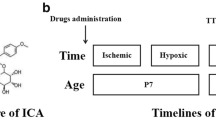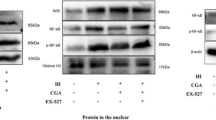Abstract
Oxygen therapy used in the treatment of perinatal hypoxia induces neurodegeneration in babies with immature antioxidant mechanisms. Zonisamide is a new antiepileptic drug used in childhood intractable seizures. Many studies demonstrated its neuroprotective effects. There is no study evaluating its effect on hyperoxic brain injury. The aim of this study was to investigate the neuroprotective effect of zonisamide on hyperoxia-induced neonatal brain injury. A total of 21 Wistar rat pups were used. The animals were divided into three groups: control group, hyperoxia group, and zonisamide-treated group. The zonisamide-treated group received an intraperitoneal injection of zonisamide. Zonisamide significantly preserved the number of neurons in CA1 and dentate gyrus parts of hippocampus, prefrontal, and parietal cortex. Zonisamide treatment also decreased the number of apoptotic neurons in all examined parts of hippocampus, prefrontal, and parietal cortex. We suggest that zonisamide treatment may be used as a neuroprotective agent in hyperoxic brain injury.



Similar content being viewed by others
References
Saugstad OD (2001) Is oxygen more toxic than currently believed? Pediatrics 108:1203–1205
Hoehn T, Felderhoff-Mueser U, Maschewski K, Stadelmann C, Sifringer M, Bittigau P, Koehne P, Hoppenz M, Obladen M, Bührer C (2003) Hyperoxia causes inducible nitric oxide synthase-mediated cellular damage to the immature rat brain. Pediatr Res 54:179–184
Felderhoff-Mueser U, Bittigau P, Sifringer M, Jarosz B, Korobowicz E, Mahler L, Piening T, Moysich A, Grune T, Thor F, Heumann R, Bührer C, Ikonomidou C (2004) Oxygen causes cell death in the developing brain. Neurobiol Dis 17:273–282
Allan SM, Rothwell NJ (2001) Cytokines and acute neurodegeneration. Nat Rev Neurosci 2:734–744
Murata M (2004) Novel therapeutic effects of the anti-convulsant, zonisamide, on parkinson’s disease. Curr Pharm Des 10:687–693
Atlı A, Dogra S (2005) Zonisamide in the treatment of painful diabetic neuropathy: a randomized, double-blind, placebo-controlled pilot study. Pain Med 6:225–234
Drake ME Jr, Greathouse NI, Renner JB, Armentbright AD (2004) Open-label zonisamide for refractory migraine. Clin Neuropharmacol 27:278–280
Rösler TW, Arias-Carrión O, Höglinger GU (2010) Zonisamide: aspects in neuroprotection. Exp Neurol 224:336–339
Kothare SV, Kaleyias J (2008) Zonisamide: review of pharmacology, clinical efficacy, tolerability, and safety. Expert Opin Drug Metab Toxicol 4:493–506
Hayakawa T, Higuchi Y, Nigami H, Hattori H (1994) Zonisamide reduces hypoxic–ischemic brain damage in neonatal rats irrespective of its anticonvulsive effect. Eur J Pharmacol 257:131–136
Owen AJ, Ijaz S, Miyashita H, Wishart T, Howlett W, Shuaib A (1997) Zonisamide as a neuroprotective agent in an adult gerbil model of global forebrain ischemia: a histological, in vivo microdialysis and behavioral study. Brain Res 770:115–122
Mori A, Noda Y, Packer L (1998) The anticonvulsant zonisamide scavenges free radicals. Epilepsy Res 30:153–158
Komatsu M, Hiramatsu M, Willmore LJ (2000) Zonisamide reduces the increase in 8-hydroxy-2′-deoxyguanosine levels formed during iron-induced epileptogenesis in the brains of rats. Epilepsia 41:1091–1094
Dobbing J (1974) The later growth of the brain and its vulnerability. Pediatrics 53:2–6
Romijn HJ, Hofman MA, Gramsbergen A (1991) At what age is the developing cerebral cortex of the rat comparable to that of the full-term newborn human baby? Early Hum Dev 26:61–67
Paxinos G, Watson C (1986) The rat brain in stereotaxic coordinates, 2nd edn. Academic Press, New York
Felderhoff-Mueser U, Sifringer M, Polley O, Dzietko M, Leineweber B, Mahler L, Baier M, Bittigau P, Obladen M, Ikonomidou C, Bührer C (2005) Caspase-1—processed interleukins in hyperoxia-induced cell death in the developing brain. Ann Neurol 57:50–55
Yis U, Kurul SH, Kumral A, Cilaker S, Tugyan K, Genc S, Yilmaz O (2008) Hyper-oxic exposure leads to cell death in the developing brain. Brain Dev 30:556–562
Gerstner B, DeSilva TM, Genz K, Armstrong A, Brehmer F, Neve RL, Felderhoff Mueser U, Volpe JJ, Rosenberg PA (2008) Hyperoxia causes maturation-dependent cell death in the developing white matter. J Neurosci 28:1236–1245
Komatsu M, Okamura Y, Hiramatsu M (1995) Free radical scavenging activity of zonisamide and its inhibitory effect on lipid peroxide formation in iron-induced epileptogenic foci of rats. Neurosciences 21:23–29
Noda Y, Mori A, Packer L (1999) Zonisamide inhibits nitric oxide synthase activity induced by N-methyl-D-aspartate and buthionine sulfoximine in the rat hippocampus. Res Commun Mol Pathol Pharmacol 105:23–33
Minato H, Kikuta C, Fujitani B, Masuda Y (1997) Protective effect of zonisamide, an antiepileptic drug, against transient focal cerebral ischemia with middle cerebral artery occlusion—reperfusion in rats. Epilepsia 38:975–980
Author information
Authors and Affiliations
Corresponding author
Rights and permissions
About this article
Cite this article
Topçu, Y., Bayram, E., Özbal, S. et al. Zonisamide attenuates hyperoxia-induced apoptosis in the developing rat brain. Neurol Sci 35, 1769–1775 (2014). https://doi.org/10.1007/s10072-014-1834-1
Received:
Accepted:
Published:
Issue Date:
DOI: https://doi.org/10.1007/s10072-014-1834-1




